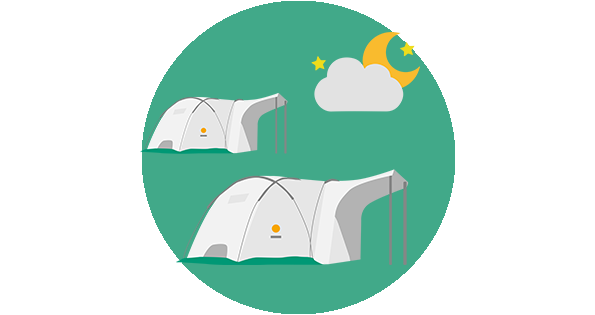RECOVERING FROM THE DEVASTATION OF THE PAKISTAN FLOODS
Ghulam's Story
Ghulam and her family lost everything in the devastating Pakistan floods in 2022. Learn about their story and recovery after the disaster.
Shelter is more than just a roof – it’s a home. It’s the foundation for life, for families, for communities.
When disasters and conflicts rob people of their homes, we can’t wave a magic wand to replace what was lost, but we can help create something new. We can provide people with the tools to start the process of their own recovery.
Your support provides shelter that protects families from burning heat, bitter cold, dangerous animals and disease, and so much more. A shelter creates a space where families can have privacy from the rest of the world, where they can feel safety and security in being together.
When people are plunged into crisis, normality is suspended. But good, quality shelter can cut through the chaos. It doesn’t just give people space to heal from physical and emotional trauma, but it gives them roots — roots that go far deeper than a simple tent peg.
Your support is amazing. Your support turns simple items like tents and tarpaulin into the tools that transform lives.
Since ShelterBox began in 2000, your support has helped us provide shelter for more than 2 million people. Two million people who not only have protection from the elements, but a place to call home.
At ShelterBox, we don’t just use our past experience to guide our future, but we keep learning, which is why we are experts in shelter. ShelterBox evaluates all of our deployments approximately six months after completion to determine if we met our short-term goals and to learn from the families we serve because we know they are the real experts.
To ensure that we are making the most of your donations, each evaluation is scored in three categories of effectiveness – timeliness, cost, and quality.
A timely response for ShelterBox is one where families agree that the aid arrived at the right time to support recovery. We calculate cost based on the average cost per household including Response Team costs, the cost of the aid, and transportation.
A high quality response refers to one that best achieves the following outcomes: reducing the number of families left homeless, reducing exposure to vector and water borne diseases, alleviating anxiety and stress for families, improved security and personal safety, improved privacy, properly training families to use the aid, keeping households intact and having an overall accountable response.
By reviewing the successes and weaknesses of the response, this enables ShelterBox to evaluate the processes and behaviours of the Response Team volunteers and staff, thereby supporting wider organizational learning and growth.
With over 20 years of experience as a global organization, we are experts in emergency shelter after disaster. We often work in places that others don’t, making sure that we reach families who need support to take the next step in resuming their livelihoods.
From Cameroon to Paraguay, all the way to the Philippines and the Caribbean, we have provided shelter to over 2 million people so far. Your support has made this possible.
Thanks to your incredible support and the help of our partners worldwide, we provided shelter to over 325,000 people in 2023.
We won’t stop until we see a world where no family goes without shelter after disaster. Will you help us?

We put families first
We have a flexible approach and we work with families to understand what they most need to support their own recovery after disaster.

We are focused
We specialize in emergency shelter and the essential tools needed to help rebuild homes after disaster.

We go further
We go to the hard-to-reach communities, often those that are overlooked by others.

We are global
We have a global network of supporters raising vital funds to help us in our mission. We are official project partners with Rotary International, and Rotarians around the world help us connect with local communities when disaster strikes.
Ghulam and her family lost everything in the devastating Pakistan floods in 2022. Learn about their story and recovery after the disaster.
We re-visited Aleu to see how the family have been getting on since receiving support from ShelterBox, partnered with Rotary, after the Turkey earthquakes.
Discover how Natalia and her daughter fled to Moldova from the Ukraine conflict, and the support they received from ShelterBox.
Samira and her six children had to flee their home after drought conditions led to conflict. Read their story and how ShelterBox has helped.
Violence caused Asiza and her family to flee their home in Sudan. They arrived in Chad and received ShelterBox aid in Zabout camp.
Bela’s home was irreparably damaged during the earthquake in Morocco. Read his journey.
Samira was home alone when the earthquake struck and her home crumbled. Read her journey.
Khadija’s family is changed since the earthquake struck. Read about her family here.
Read more about Aleu, Celal, and Huseyin and their stories following the earthquakes.
Joined by renowned photographer, Sian Davey, and filmmaker Benn Berkley, we documented Mwalija village’s journey of self-recovery in a project we called ‘Kunyumba’ (meaning ‘home’).
Thanks to our supporters, we helped nearly 100,000 people after Typhoon Rai hit the Philippines. Let’s look at our response more closely.
ShelterBox has supported over 2 million people in their recovery after disaster, all thanks to our supporters! Learn more about our top responses.